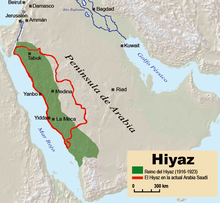Hejaz
The Hejaz or Hijaz ( Arabic الحجاز al-Hijāz , DMG al-Ḥiǧāz ) is a landscape in western Saudi Arabia , in which the two holy places of Islam , Mecca and Medina , are located.
geography
The Hejaz landscape is 461,111 km² in size and covers the north-western part of the Arabian Peninsula as far as the Yemeni mountainous region, more recently often only to the border of the ʿAsīr landscape .
To the north, the Hejaz is not clearly demarcated from the region called Shām ( Greater Syria with Jordan and Palestine ). In the west, the Red Sea forms the natural boundary.
At the height of Wadi Hamadh, the Midian landscape begins , which is often not counted as part of the Hejaz proper and which extends as far as ʿAqaba . The dry coastal plain of the Tihama is also often not counted as part of the Hejaz. The demarcation to the east to the Nedschd (Nedschd means highlands) is not very clear.
Soil shape, climate
From the coast of the Red Sea the mountains rise to 2,446 m and then slowly drop to the east. The precipitation varies from year to year and reaches a maximum of 600 mm, on average, depending on the altitude, mostly only between 100 and 300 mm. It gets very humid on the coast in summer.
structure
Today, no administrative unit in Saudi Arabia corresponds to the historical landscape of Hejaz.
| location | province | Arabic | Capital | Area km² |
Population 2004 1) |
density | Governorates |
|---|---|---|---|---|---|---|---|

|
Taboo | تبوك | Taboo | 146.072 | 691.517 | 4.7 | 6th |

|
al-Madina | المدينة | Medina | 151.990 | 1,512,076 | 9.9 | 7th |

|
Makka | مكة | Mecca | 153.128 | 5,797,971 | 37.9 | 12 |

|
al-Baha | الباحة | al-Baha | 9,921 | 377.739 | 38.1 | 7th |
population
More than six million people live in the Hejaz, mostly Sunni Arabs. Iǧāzi , a peculiar dialect of Arabic, is widespread among the Arab population of the region . The most important cities are Mecca, Medina, Jeddah , Ta'if , Tabuk , Yanbu , al-Wajh and Rabigh.
economy
Due to the desert climate, only Bedouin farming and, in a few oases, agriculture is possible. Trade traditionally plays an important role. The annual pilgrimage ( Hajj ) is also an important economic factor.
history
In the 7th century under Mohammed, the Hejaz was the starting point of Islam , which after the establishment of the caliphate spread over large parts of the Middle East and North Africa . However, the country soon lost its political importance when the Umayyads moved their residence to Damascus in 661 . From the late 10th century the Hejaz was ruled by the Sherif of Mecca , who successively recognized the supremacy of various Muslim dynasties, such as the Fatimids , Ayyubids and Mamluks . In 1517 the Ottomans took over rule. In the second half of the 19th century they tried to bring the Hejaz under their control and initially formed the Eyâlet Jeddah, which emerged from the Habeş Eyaleti , and from which, after the Vilayet reform from 1867, the new province of Hejaz . The construction of the Hejaz Railway also served this purpose. On the eve of the First World War , the Sanjak Medina was spun off as an independent sanjak and placed directly under the central government.
Hussein ibn Ali , Grand Sherif of Mecca since 1908, began the uprising against the Ottomans during the First World War in 1916 , in which he was supported by Lawrence of Arabia and Great Britain . However, Britain's promises to establish an Arab kingdom after the war were not kept. Even as King of the Hejaz (1916-1924), Hussain could not assert himself against the Wahhabis and Abd al-Aziz ibn Saud . In 1926 the Kingdom of Hejaz was united with the Najd and in 1932 it became part of the Kingdom of Saudi Arabia.
Web links
Individual evidence
- ↑ Hans-Jürgen Kornrumpf: The Ottoman rule on the Arabian peninsula in the 19th century in: Hans-Jürgen Kornrumpf: Contributions to Ottoman history and territorial administration. Isis, Istanbul 2001, ISBN 975-428-199-8 , pp. 40-50

